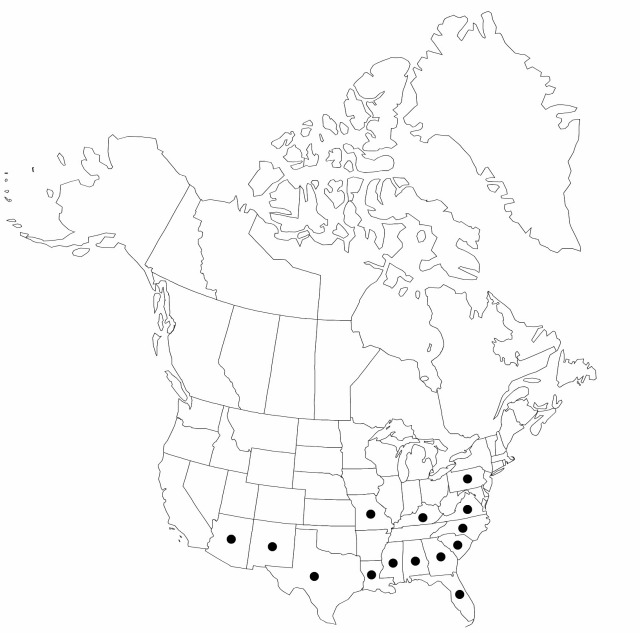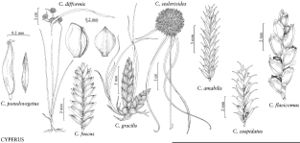Cyperus flavicomus
Fl. Bor.-Amer. 1: 27. 1803.
Herbs, annual, cespitose or single-stemmed. Culms trigonous, easily compressed, 30–75 cm × 1–5 mm, basally soft, glabrous. Leaves 1–3, usually withered at anthesis, V-shaped, 5–35 cm × 2–8 mm. Inflorescences: spikes loosely ovoid, 5–25 × 8–22 mm; rays (3–)5–11, 0.4–20 cm; 2d order rays occasionally present, 5–28 mm; bracts 3–7, horizontal to ascending at 30°, (2–)8–35 cm × (1–)4–10 mm. Spikelets 6–60, linear to lanceoloid, 7–30 × 2–3 mm, margins appearing serrate; floral scales 6–24, loosely overlapping, light brown to reddish brown, with conspicuous clear border, medially greenish, 5–7-ribbed, ovate-obovate, (1.4–)1.7–2.3 × 1.4–2 mm, apex acute to obtuse. Flowers: stamens 2–3; anthers 0.4 mm, connective apex reddish, to 0.1 mm; styles 0.1–0.3 mm; stigmas 0.7–1.5 mm. Achenes jet black to dark reddish brown, sessile, obovoid, broadly rounded, 1.2–1.6 × 0.6–1.1 mm, surfaces minutely punctate.
Phenology: Fruiting summer–early fall.
Habitat: Emergent shorelines, roadsides ditches, marshes
Elevation: 0–200 m
Distribution

Ala., Ariz., Fla., Ga., Ky., La., Miss., Mo., N.Mex., N.C., Pa., S.C., Tex., Va., Mexico, Central America, South America, Asia, Africa.
Discussion
Cyperus flavicomus has long been called C. albomarginatus (see G. C. Tucker 1994). The closely related (perhaps not distinct) C. macrostachyos Lamarck, a pantropical subspecies, has been reported from Central America; the relationship of the two species needs further study.
Cyperus flavicomus has been introduced in New York; it has not persisted there (R. S. Mitchell and G. C. Tucker 1997).
Selected References
None.
